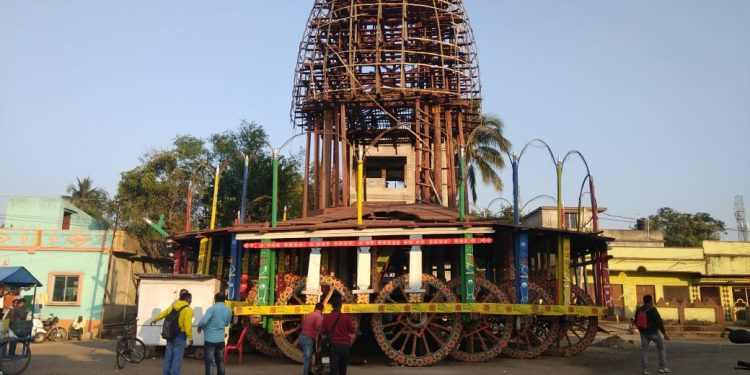Keonjhar: After being recognised as world’s tallest chariot by several organisations including the Global Records and Research Foundation (GRRF) and Asia Pacific and Indian National Records, the 72-feet tall chariot of Lord Baldevjew here has been the centre of attraction for tourists and devotees. Administrative apathy, however, raises concerns on its longevity and sanctity.
Even though the chariot has placed the district prominently on the global map, it has been left uncared for and unprotected. This has caused resentment among the people here.
Even though several tourist spots in this district including ‘Sana Ghagara’ waterfalls attract many annually, this chariot in Old Town is the pride of the district. The footfalls have increased since it was declared as the tallest chariot in the world.
During the nine-day long car festival (Ratha Yatra), the chariot becomes the point of attraction. But once the festivities are over, the chariot is left unattended in front of Lord Baldevjew’s temple for the rest of the year, till the next festival comes along. It lies in open unprotected, from the scorching sun and pounding rain.
Hence the logs and wood pieces suffer damage. It is only when the car festival again approaches the old and damaged pieces are replaced with new ones to make the chariot ready.
Citing the example of Puri where the three chariots are dismantled every year after the car festival, some local residents demanded implementation of a similar system. They alleged that to make the chariot architectures’ job easy and citing the scarcity of some specific type of woods needed to build the chariot, the system of dismantling is not being implemented here.
Environmental impact aside, there is no dearth of the kind of wood needed in constructing the chariot in Keonjhar district. Money can never be a matter of concern as the deities have large amounts of immovable and moveable properties. The deities too have vast stretches forestland in their names.
“Despite the deities having their own estates, at the time of car festival, royalty is paid to the forest department for the woods used in the chariot construction,” observed Naba Kishore Sahu, a senior citizen. “Due to lack of proper administrative measures, the forest department makes money when it is not supposed to do so,” he added.
As the chariot is parked in open without any protection, it becomes an easy access for both animals and human beings. Stray dogs and cattle are seen sleeping in its shade. They spoil the sanctity by relieving themselves on or near the chariot. At nights, anti-socials take siege of it.
Devotees, tourists and local residents are critical about this gross sacrilege.
“Leaving the chariot in open is good. Tourists and visitors are getting a chance to admire it. But it needs to be surrounded by a fence and the site should be well illuminated, so that those visiting at night can have a better view.
Speaking on the subject, sub-collector and executive officer of Debottar department Somnath Pradhan said, “The chariot is the pride of the district. Steps for safety of the chariot and to make the car festival more enjoyable would definitely be taken.”
It may be mentioned here that popularly known as ‘Nandighosh’, the single chariot here carries the trinity of Lord Balabhadra, Lord Jagannath and Devi Subhadra to Mausi Maa temple on the occasion of car festival. Car pulling in the Old Town here is a 400-year-old tradition.
PNN






































